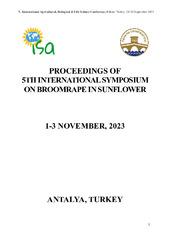Prikaz osnovnih podataka o dokumentu
Wild Helianthus species as a valuable breeding source for broomrape resistance of cultivated sunflower (Helianthus annuus L.)
| dc.creator | Jocković, Jelena | |
| dc.creator | Cvejić, Sandra | |
| dc.creator | Radanović, Aleksandra | |
| dc.creator | Jocković, Milan | |
| dc.creator | Jocić, Siniša | |
| dc.creator | Miladinović, Dragana | |
| dc.creator | Zorić, Lana | |
| dc.creator | Luković, Jadranka | |
| dc.date.accessioned | 2023-11-21T11:54:06Z | |
| dc.date.available | 2023-11-21T11:54:06Z | |
| dc.date.issued | 2023 | |
| dc.identifier.isbn | 978-625-00-1676-3 | |
| dc.identifier.uri | http://fiver.ifvcns.rs/handle/123456789/4021 | |
| dc.description.abstract | Sunflower is an important industrial crop. Together with the expansion of the production areas, the challenges in growing sunflower are becoming tougher. Undoubtedly one of the most important problems in sunflower cultivation is the parasitic plant broomrape (Orobanche cumana). The first use of wild Helianthus species for introduction of broomrape resistance dates from the first half of 20th century when Russian academician Zhdanov developed resistant sunflower genotypes from interspecific crosses with H. tuberosus, H. mollis and H. maximiliani. Taking into account the ability of broomrape to evolve into more aggressive races and thus overcome the resistance genes, scientists are forced to constantly search for new sources of resistance. As a result, sources with different levels of resistance are found in H. tuberosus, H. mollis, H. maximiliani, H. nuttalii, H. debilis, H. neglectus, H. niveus, H. argophyllus, H. divaricatus, H. bolanderi, H. petiolaris, H. praecox, H. deserticola and H. grosseserratus. Breeding for genetic resistance is even more challenging due to the existence of not only large broomrape interpopulation divergence, but also intrapopulation divergence. One of the areas that has not received enough attention is the anatomical characterization of the root of wild sunflower species and sunflower in general. It is known that pre-haustorial resistance to broomrape is determined by the development of physical barriers in host root cell walls, which prevents linkage of broomrape to the host. A detailed anatomical characterization of root in wild Helianthus species can give valuable information about differences between the species and more knowledge about the nature of resistance of certain Helianthus species to broomrape. | sr |
| dc.language.iso | en | sr |
| dc.publisher | Edirne : Trakya University | sr |
| dc.relation | info:eu-repo/grantAgreement/MESTD/inst-2020/200032/RS// | sr |
| dc.relation | info:eu-repo/grantAgreement/EC/HE/101059784/EU// | sr |
| dc.relation | info:eu-repo/grantAgreement/ScienceFundRS/Ideje/7732457/RS// | sr |
| dc.relation | Climate Crops - Centre of Excellence for Innovations in Breeding of Climate-Resilient Crops, Institute of Field and Vegetable Crops | |
| dc.rights | openAccess | sr |
| dc.rights.uri | https://creativecommons.org/licenses/by/4.0/ | |
| dc.source | Proceedings, 5th International Symposium on broomrape in sunflower, 1-3 November 2023, Antalya | sr |
| dc.subject | wild sunflower | sr |
| dc.subject | broomrape | sr |
| dc.subject | resistance | sr |
| dc.title | Wild Helianthus species as a valuable breeding source for broomrape resistance of cultivated sunflower (Helianthus annuus L.) | sr |
| dc.type | conferenceObject | sr |
| dc.rights.license | BY | sr |
| dc.citation.epage | 12 | |
| dc.citation.spage | 11 | |
| dc.identifier.fulltext | http://fiver.ifvcns.rs/bitstream/id/9780/bitstream_9780.pdf | |
| dc.identifier.rcub | https://hdl.handle.net/21.15107/rcub_fiver_4021 | |
| dc.type.version | publishedVersion | sr |


